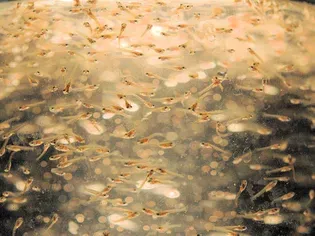Culling Aquarium Fish
Updated on 05/26/24

The Art of Aquarium Fish Culling: Essential Considerations for the Health and Well-being of Your Underwater Oasis
Maintaining a thriving aquarium environment requires a delicate balance between the needs of your aquatic inhabitants and the limitations of their aquatic abode. Culling, the selective removal of certain fish from the aquarium, can be a necessary practice to ensure the optimal health and welfare of your underwater community.
However, culling fish is not a decision to be taken lightly. It requires careful consideration, ethical judgment, and a thorough understanding of the potential implications. In this comprehensive guide, we will explore the complexities of culling aquarium fish, providing you with the knowledge and insights to make informed decisions that prioritize the well-being of your aquatic ecosystem.
Understanding the Rationale for Culling Aquarium Fish
Culling may become necessary in various situations to maintain a healthy and balanced aquarium environment:
Overpopulation: As fish populations grow, overcrowding can lead to stress, reduced growth rates, and increased susceptibility to diseases. Culling can help control fish numbers, ensuring adequate space and resources for each inhabitant.
Health Concerns: Removing diseased or deformed fish from the aquarium can prevent the spread of contagious illnesses and improve the overall health of the remaining population.
Aggressive Behavior: Some fish species may exhibit aggressive behavior toward others, causing injury or even death. Culling aggressive individuals can create a more peaceful and harmonious environment.
Inbreeding: In closed aquarium systems, inbreeding can lead to genetic defects and decreased reproductive success. Culling can help prevent these issues by promoting genetic diversity.
Ethical Considerations and Humane Practices
Culling should always be guided by ethical principles and carried out humanely. Humane euthanasia methods include:
Immersion in Clove Oil: Clove oil induces sedation and respiratory depression, providing a relatively painless passing.
Tricaine Methanesulfonate (MS-222): This anesthetic agent causes a loss of consciousness and respiratory arrest, ensuring a gentle euthanasia process.
Freezing: This method can be used for large fish or groups of fish. Place the fish in a sealed plastic bag with a small amount of water and freeze rapidly.
Important Considerations Prior to Culling
1. Proper Planning:
* Determine the specific reason for culling based on your aquarium observations.
* Estimate the number of fish that need to be removed.
* Choose an appropriate euthanasia method.
2. Quarantine and Observation:
* Isolate the fish intended for culling in a quarantine tank for a few days.
* Observe them closely for any signs of disease or unusual behavior.
* Treat any sick fish before proceeding with culling.
3. Selection Criteria:
* Prioritize removing diseased or deformed fish.
* Consider removing aggressive individuals or fish that are disrupting the community harmony.
* Select the smallest or least healthy specimens.
4. Gradual Reduction:
* Avoid removing a large number of fish at once.
* Gradually reduce the population over time to minimize stress on the remaining fish.
5. Environmental Adjustments:
* Ensure that the remaining fish have adequate space, hiding places, and resources.
* Monitor water quality and make adjustments as needed.
Conclusion
Culling aquarium fish is a complex and multifaceted practice that requires a balance of compassion, scientific understanding, and ethical considerations. By following the principles outlined in this guide, you can approach culling decisions with confidence, ensuring the health and well-being of your underwater inhabitants. Remember, the ultimate goal is to create a harmonious and thriving aquarium ecosystem where all fish can flourish.
Explore More Pets

Freshwater Aquarium Filters
How to Deal With Cloudy Aquarium Water

Saltwater Aquarium Filters
How Do You Remove Chloramines From Tap Water?

Freshwater Aquariums & Habitat
Can I Keep My Koi Fish Inside?

Saltwater Aquariums & Habitat
14 Best Floating Plants for Your Aquarium

Freshwater Fish Health
How to Treat Ich on Freshwater Fish

Saltwater Fish Health
Fin Rot in Aquarium Fish

Freshwater Aquarium Filters
How to Do Aquarium Water Changes

Saltwater Fish Health
How Do Fish Get Parasites?
